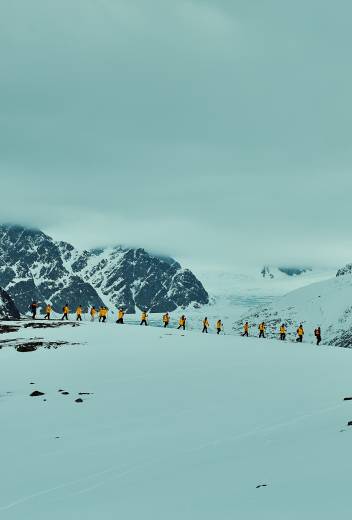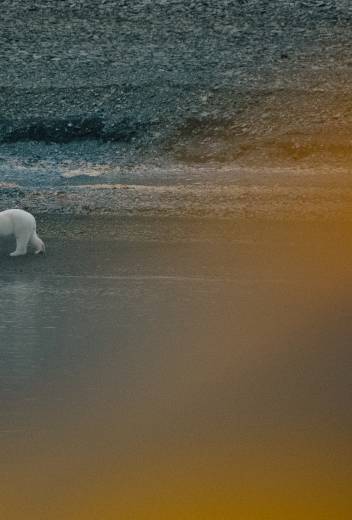Every traveler has their own particular obsession when it comes to landforms. Icebergs and glaciers seemed to fascinate so many polar travelers. Yet others are smitten with volcanoes—and still others who have an unquenchable thirst for remote northern rivers. Fjords are among those entities that figure into the dreams of many travelers because of their size—and their seemingly limitless natural wonders.
A fjord can be best described as an expanded, deep and particularly narrow sea, ‘lake drain’ or ‘undersea valley,’ typically surrounded by a steep, rugged and dramatic landscape. Fjords are much much longer than they are wide. Fjords have been carved and shaped by glacial erosion throughout multiple ice ages. Fjords are natural harbors, quieter and calmer than the open seas, and many are included on the UNESCO (United Nations Educational Scientific and Cultural Organisation) world heritage list.
‘Fjord’ comes from the Norwegian word for ‘where one fares through.’ In the Ice Age, through a process called ‘glaciation,’ expansive glaciers moved along, over the Earth’s surface, leaving a U-shaped valley in its tracks, in tandem with ice segregation and abrasion of the surrounding rock formations. These valleys then become ‘fjords’ when they are flooded by the ocean. Most fjords are deeper than the adjacent sea. However, the entrance towards the sea is called the mouth of the fjord and is often shallow. Sognefjord in Norway, for example, reaches 1300m below sea level.
Commonly, fjords have a shoal or bedrock at their mouth, which is generally caused by the glacier’s lesser erosion in this area. This can cause strong currents and occasionally rapids. This is another element of fjords which distinguish themselves from what could otherwise be described as a bay.
Where are the Fjords?
Fjords are a natural part of the landscape in many parts of the Arctic and Antarctic, making fjords excursions a common activity in many voyages.
Apart from the famous Norweigan fjords (Norway’s coastline is estimated at 29,000 km with nearly 1,200 fjords) they’re also found in parts of Alaska, Canada, Denmark, Iceland, Scotland, Greenland, New Zealand and Chile. Below are three regions with impressive fjords, all of which are visited on voyages with Quark Expeditions.
Guests traveling with Quark Expeditions get to spend time exploring the historic settlement of
Port Stanley in the Falkland Islands (Islas Malvinas). Photo: Sam Crimmin
Fjords of Greenland
Greenland is home to some of the most incredible fjords on the planet. On a Quark Expeditions Zodiac excursion, guests are able to enjoy an intimate fjord experience. Some of Quark Expeditions’ Greenland voyages take visitors to Ilulissat, one of the most prominent of the Greenland fjords, located 100km north of the Arctic Circle. Our new innovative Greenland Adventure: Explore by Sea, Land and Air expedition is based in and along the Tasermiut fjord in South Greenland, providing guests with the opportunity to explore the 70 km -ong fjord by ship, Zodiac and by helicopter, with an opportunity to overnight camp by the Tasermiut fjord itself.
Fjords of Spitsbergen, Norwegian Arctic
Spitsbergen is the largest island in the Norwegian archipelago of Svalbard, often referred to as ‘the wildlife capital of the Arctic.’ Many of our voyages in this Norwegian Arctic archipelago devote time to exploring the fjords. The Spitsbergen: Fjords, Glaciers and Wildlife of Svalbard itinerary is an ideal way to observe the wildlife that make their home in and along the rugged fjords of Svalbard, such as polar bear, walrus, reindeer, arctic fox, beluga whale, seals and seabirds.
Fjords of Chile
Southern Patagonia provides some of the most enchanting, remote landscapes on earth. Our Essential Patagonia: Chilean Fjords and Torres del Paine expedition is a monumental voyage into Chile’s sensational network of fjords and channels. Spot Magellanic penguins and South American sea lions and elephant seals against a hypnotic background of tidewater glaciers. Of course, there are fjords to be discovered and explored on our polar voyages into the Antarctic as well.
Guests traveling with Quark Expeditions get to spend time exploring the historic settlement of
Port Stanley in the Falkland Islands (Islas Malvinas). Photo: AdobeStock
Cruise around the Fjords
When selecting a polar ‘cruise’ —or polar expedition—it’s essential to travel with experienced polar experts you can trust. Quark Expeditions’ voyages are staffed by seasoned polar experts who are equipped to safely immerse you in the polar wilderness. As well, the onboard team of guides and polar experts will do everything to ensure you get off the ship and into the raw polar landscape as often as possible.
One of the signature elements of a fjords cruise is the abundance of wildlife which inhabit and feed in the elongated waterbody. The fjords are a prime place to view whales, seals and polar bears, depending on the Arctic region.
Quark Expeditions is well-equipped to explore fjords. None of its fleet of small polar vessels carries more than 199 passengers. The smaller ship size enables Quark Expeditions’ team to navigate where other ships can’t. Of course, the onboard Zodiacs, inflatable sturdy aircraft, provide guests with an intimate fjord excursion in small groups—which is ideal for photographers. And the two twin engine helicopters aboard our newest ship, Ultramarine, provide guests with aerial views of mammoth fjords that form memories of a lifetime.









